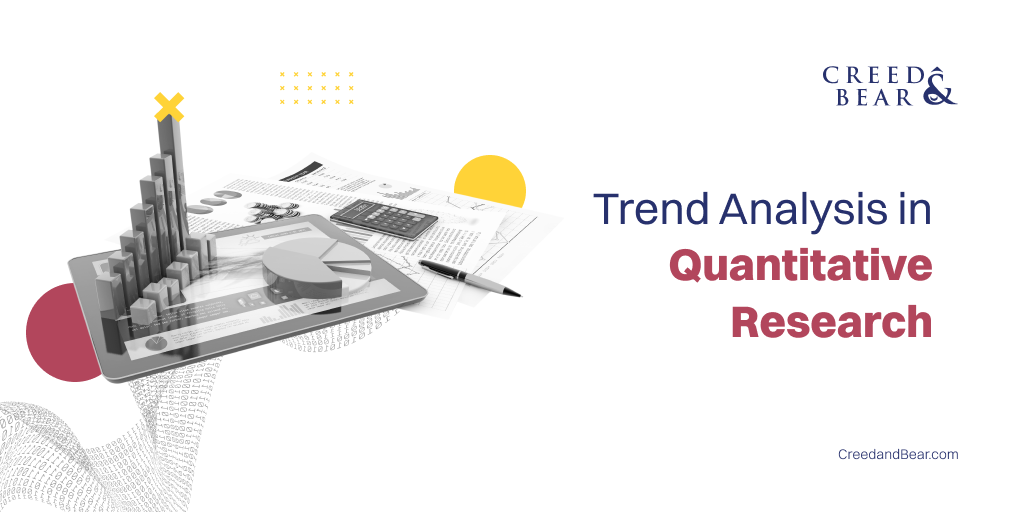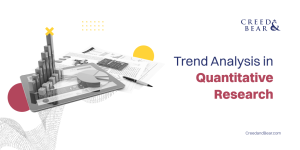One way of learning from the past is to identify and study patterns. When we peer into the past, we can find a specific trend or pattern that can indicate what might happen in the future.
In quantitative research, the concept is called Trend Analysis. It is a specific technique used to analyze said patterns and tendencies in numerical data over time. Additionally, it involves examining historical data to identify trends, cycles, and variations that may provide insights into a phenomenon.
Trend analysis plays a crucial role in various fields, including economics, finance, epidemiology, and environmental science. Consequently, this helps researchers understand the past, predict the future, and make informed decisions.
What is Trend Analysis?
Trend analysis involves the systematic examination of data to discern consistent patterns or trends over time. These patterns may manifest as upward or downward movements, cycles, or fluctuations in the data series. By analyzing these trends, researchers can gain valuable insights into the behavior of the variable and its relationship with other factors.
Fundamental Components of Trend Analysis
Trend analysis encompasses several key components. All that is essential for understanding and interpreting patterns in numerical data over time. Let’s delve into each of these components in detail:
Data Collection and Preparation
- Data Sourcing: Trend analysis begins with collecting relevant numerical data from reputable sources. This may include historical records, databases, or real-time data feeds.
- Data Cleaning: Once collected, the data undergoes thorough cleaning to remove any errors, inconsistencies, or outliers. This ensures the integrity and reliability of the dataset for analysis.
- Data Transformation: Data may be transformed or aggregated into meaningful units (e.g., monthly averages and yearly totals) to facilitate trend analysis and improve interpretability.
Visualization
- Graphical Representation: Visualizing the data using graphs, charts, or plots is instrumental in identifying trends and patterns. Line charts, bar graphs, and histograms are commonly used to visualize time-series data.
Trend Identification
- Pattern Recognition: Analysts examine the data to identify recurring patterns or trends over the observation period. Meanwhile, these trends may manifest as upward, downward, or horizontal movements in the data series.
- Statistical Analysis: Statistical techniques, such as calculating moving averages or trendlines, are employed to quantify and describe the observed trends objectively.
Statistical Analysis
- Moving Averages: Moving averages smooth out short-term fluctuations in the data to highlight long-term trends. Common types include simple moving averages (SMA) and exponential moving averages (EMA).
- Trendlines: Trendlines are linear regression lines fitted to the data to illustrate the overall trend. They provide insights into the direction and strength of the trend over time.
- Statistical Tests: Various statistical tests like the Mann-Kendall test or the Hodrick-Prescott filter can be run. They may assess the significance of observed trends and detect changes in trend behavior.
Examples of Trend Analysis
Let’s look at a few examples to illustrate how trend analysis is applied in different fields:
- Economics: Trend analysis is used to analyze long-term economic trends such as GDP growth, inflation, and unemployment. By examining historical data, economists can identify economic patterns and cycles and make forecasts about future economic conditions.
- Finance: In finance, trend analysis is commonly used to analyze stock price movements, identify market trends, and inform trading decisions. Traders use technical analysis techniques such as moving averages and trendlines to identify trends in stock prices and anticipate future price movements.
- Epidemiology: In epidemiology, trend analysis is used to monitor the spread of infectious diseases and identify outbreaks. Epidemiologists analyze data on disease incidence rates, hospitalizations, and mortality rates to identify trends and patterns in disease transmission and inform public health interventions.
- Environmental Science: In environmental science, trend analysis is used to analyze environmental data such as temperature readings, rainfall patterns, and air quality measurements. By examining long-term trends in environmental data, researchers can assess the impact of human activities on the environment and identify potential areas for intervention.
Conclusion
Trend analysis is a powerful technique used in quantitative research to analyze patterns and tendencies in numerical data over time. Researchers gain valuable insights from the study, make predictions, and inform decision-making based on empirical evidence. Trend analysis plays a crucial role in various fields, helping researchers understand the past, predict the future, and address complex challenges in today’s world.
About Creed&Bear
Creed&Bear leverages cutting-edge technologies to deliver modern solutions. To know more about us, visit our website, read our blog, or follow us on social media.
Website 🔗 https://creedandbear.com/
AI Usage: This article was initially drafted with the assistance of artificial intelligence and subsequently edited to ensure originality and avoid plagiarism. However, in the event that the content inadvertently resembles other works, we do not assume responsibility for any unintentional overlaps or similarities. We invite readers to notify us of any such resemblances so that we can make the necessary modifications in respect and consideration of other authors and brands.
Finance and Trading: The insights and opinions expressed in this blog post concerning trading and market are solely those of the author and should not be interpreted as financial advice. This content is for informational purposes only and does not constitute recommendations or endorsements for any specific investments, securities, or financial strategies. Readers should conduct their own research or consult with a financial professional before making any investment decisions.





